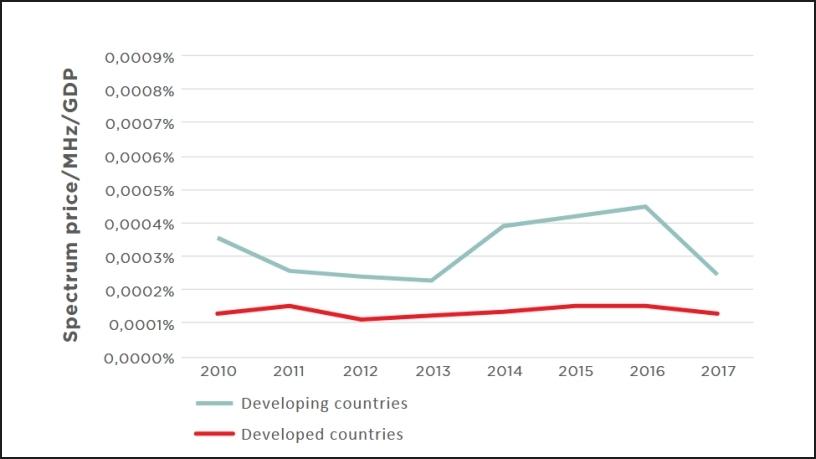
Spectrum prices in developing countries are, on average, more than three times higher than in developed countries, when income is taken into account.
This is according to Spectrum Pricing in Developing Countries, a new report released by the GSM Association (GSMA) yesterday, which found high spectrum pricing is a major roadblock to increasing mobile penetration in developing nations.
The study was designed to identify and investigate trends in spectrum pricing in developing countries, their drivers and potential impact on consumers.
Government and regulators were found to play a key role in increasing spectrum prices through policy decisions. Administrations are able to do this by setting very high reserve prices for spectrum auctions, constricting the supply of spectrum, which forces operators to overpay, not publish a spectrum roadmap and use poor award rules.
The organisation says policies that seek to maximise state revenues can have a negative influence on consumer outcomes, including more expensive mobile services and reduced network investment.
Better spectrum pricing policies are needed in developing countries to improve the economic and social welfare of the billions of people that remain unconnected to mobile broadband services, highlights the report.
"Connecting everyone becomes impossible without better policy decisions on spectrum," says Brett Tarnutzer, head of spectrum at the GSMA.
He continues: "For far too long, the success of spectrum auctions has been judged on how much revenue can be raised rather than the economic and social benefits of connecting people. Spectrum policies that inflate prices and focus on short-term gains are incompatible with our shared goals of delivering better and more affordable mobile broadband services.
"These pricing policies will only limit the growth of the digital economy and make it harder to eradicate poverty, deliver better healthcare and education, and achieve financial inclusion and gender equality."

The GSMA analysis is based on the assessment of over 1 000 spectrum assignments across 102 countries, including 60 developing and 42 developed countries, from 2010 through 2017.
Among the countries included in the analysis are Algeria, Cameroon, Bangladesh, Brazil, Colombia, Egypt, Ghana, India, Jordan, Mexico, Myanmar and Thailand; all markets where spectrum licensing is a priority.
Although SA is also a developing nation and allocation of more high demand spectrum has been a priority for local mobile operators, the country was not included in the study.
The long wait
The South African market has had a spectrum scarcity issue for years now. There have been countless calls to government to provide clarity and fast-track spectrum allocation for the telcos.
In July 2016, the Independent Communications Authority of SA (ICASA) issued an invitation to operators to apply for licences for spectrum in the 700MHz, 800MHz and 2.6GHz bands, to be used to provide mobile broadband wireless access services.
However, Siyabonga Cwele, minister in the Department of Telecommunications and Postal Services (DTPS), challenged the move in court and won an interdict to halt ICASA's planned spectrum auction.
The National Integrated ICT Policy White Paper was then released in September 2016 and proposed a shake-up of the previous policy framework for spectrum allocation in favour of an "open access regime". This is in the form of a wireless open access network (WOAN), which garnered criticism from many stakeholders in the sector.
Some operators suggested a hybrid model where the WOAN receives the bulk of spectrum but operators are also given individual spectrum allocations. This is where a CSIR study came in, to determine how much spectrum the planned WOAN would need and how much would be left over for private companies. The study was completed in October 2017 but the findings have not yet been made public.
Last August, the GSMA released a report warning countries against implementing a WOAN model. It found WOANs do not deliver on promises to provide better coverage, more competition, or lower prices for consumers, with most failing to get off the ground.
The GSMA cautioned South African government, highlighting that if it goes ahead with its plans, it could have irreversible repercussions and result in a negative impact on the economy.
Despite this, the Electronic Communications Amendment (ECA) Bill, which seeks to implement and give effect to the policy objectives set out in the ICT White Paper, was approved by Cabinet in November 2017.
Telecoms operators and industry players submitted comments on the ECA Bill in January, and in March, industry stakeholders participated in an industry consultation workshop on the ECA Bill.
The DTPS is yet to provide an update following the submission of comments, but in May minister Cwele indicated a decision on the future of spectrum allocation in SA will soon be made by Cabinet.
Successful recipe
The GSMA is of the view that a well-designed spectrum policy is a critical input for a thriving digital economy.
The report notes high spectrum prices and lack of transparency in assigning spectrum can discourage LTE rollouts, constrain consumer welfare and delay the closing of the digital divide.
"Making substantial amounts of spectrum available at prices that lead to an efficient and growth-promoting allocation of spectrum can help realise vital digital development goals through affordable, high-quality and widespread broadband services," it says.
"With advanced 4G technologies requiring increasing amounts of spectrum, it is crucial that spectrum policies in developing countries support fast and sustainable development of the mobile sector. This helps realise maximum benefit for citizens, particularly the digitally excluded."
The GSMA report puts forward four ways to remedy issues of high spectrum prices for developing nations. The first is to set modest reserve prices and annual fees, and rely on the market to set prices. Number two is to license spectrum as soon as it is needed and avoid artificial spectrum scarcity. The third is to avoid measures which increase risks for operators; and lastly to publish long-term spectrum award plans.
Share